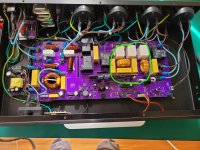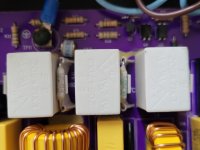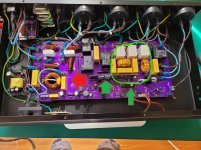Hi everyone,
I have a 'Monster Power HDP1750G+ Powercenter' power conditioner which is making a loud buzzing noise.
The unit seems to be working fine other than the buzzing noise.
When you plug it in there is no noise. You turn the power switch on, and there is a low volume buzzing noise from the left hand side of the unit. Then after about 10 seconds a relay kicks in and a loud buzzing noise comes from the right hand side of the unit.
I have contacted Monster and they have told me that this noise is the surge protection circuitry kicking in and that I should dispose of the unit.
They have also advise there are no schematics available for this unit.
I have opened the unit up and everything looks clean and healthy (nothing looks blown or damaged).
The buzzing seems to be coming from the section with the varistors, chokes, caps, and relays (circled in the picture)
Has anyone come across this problem with a Monster power condition before?
I am suspecting it's the varistors which is making the noise and needs changing? Am I correct in my assumption?
If so, is it something I should do? Or is it time to dispose of the unit?
Thanks
I have a 'Monster Power HDP1750G+ Powercenter' power conditioner which is making a loud buzzing noise.
The unit seems to be working fine other than the buzzing noise.
When you plug it in there is no noise. You turn the power switch on, and there is a low volume buzzing noise from the left hand side of the unit. Then after about 10 seconds a relay kicks in and a loud buzzing noise comes from the right hand side of the unit.
I have contacted Monster and they have told me that this noise is the surge protection circuitry kicking in and that I should dispose of the unit.
They have also advise there are no schematics available for this unit.
I have opened the unit up and everything looks clean and healthy (nothing looks blown or damaged).
The buzzing seems to be coming from the section with the varistors, chokes, caps, and relays (circled in the picture)
Has anyone come across this problem with a Monster power condition before?
I am suspecting it's the varistors which is making the noise and needs changing? Am I correct in my assumption?
If so, is it something I should do? Or is it time to dispose of the unit?
Thanks
Attachments
Last edited:
Use a plastic rod, or old ball pen, touch each part, works like a stethoscope. Will tell what is vibrating and causing the sound.
And check for dry joints.
The odd looking relay on the left of the circled area is possibly a relay with overload built in, those go faulty at times.
Another fault is that the DC to relay coils may be faulty: low voltage, bad diodes and caps.Those need checking too.
OBSERVE HIGH VOLTAGE PRECAUTIONS!
And check for dry joints.
The odd looking relay on the left of the circled area is possibly a relay with overload built in, those go faulty at times.
Another fault is that the DC to relay coils may be faulty: low voltage, bad diodes and caps.Those need checking too.
OBSERVE HIGH VOLTAGE PRECAUTIONS!
The odd looking relay on the left of the circled area is possibly a relay with overload built in, those go faulty at times.
The blac ones are just plain 24V SPST relays, (there are two 12V and two 24V there.)
This - I like to use a wooden spoonUse a plastic rod, or old ball pen, touch each part, works like a stethoscope. Will tell what is vibrating and causing the sound.
But it could be some sort of drive/control fault, I'd be interested in checking the small smd caps on the small daughter board
This - I like to use a wooden spoon- you should be able to find the component that is causing the problem... depends what sort of buzzing it is though.
I have used a small piece of wood (chopstick) and have touched all those components and unable to see which one is making the noise.
The noise remains the same whichever component I touch, and I can't see any vibrations through the chopstick.
But it could be some sort of drive/control fault, I'd be interested in checking the small smd caps on the small daughter board
Is the daughter board the small board on the bottom left of the picture? If so I can't see any smd caps. Which ones are you referring to?
Thanks
The two small boards next to the chokes on the right side...check those.
Vertical to the main board.
I have visually looked at used the stick on those boards, but no vibration.
They are soldered in, so I will go about removing them this weekend.
Should I replace the smd caps with smd caps? Or just normal caps?
I have noticed a couple of things.
1. When the unit was in my house it shows 240V. When I have the unit in my garage, it shows 236 - 237V. Is this normal voltage fluctuations during different times of the day? Or voltage drop going from my house to garage? Or is there something not right about my power?
2. Where the big white things are (I think they're varistors) there are some smaller things which look like big resistors. I'm guessing they are fuses? All of them have green writing except 1 which has black writing. Is this an indication of anything? I have included a photo.
Thanks
Attachments
The daughter board possibly supply power to the relays, if power is not clean, the relays will buzz.
Even the transformer may buzz...
You will have to do a close inspection.
If it is a new topic for you, read up on line voltage stabilizer / regulator, the workings are described.
That will give you a better idea of what is going on.
Here 5% voltage fluctuation is normal, don't worry, just check if wire termination is properly tightened.
Again, observe mains voltage precautions.
Even the transformer may buzz...
You will have to do a close inspection.
If it is a new topic for you, read up on line voltage stabilizer / regulator, the workings are described.
That will give you a better idea of what is going on.
Here 5% voltage fluctuation is normal, don't worry, just check if wire termination is properly tightened.
Again, observe mains voltage precautions.
....When the unit was in my house it shows 240V. When I have the unit in my garage, it shows 236 - 237V. Is this normal voltage fluctuations during different times of the day? Or voltage drop going from my house to garage? Or is there something not right about my power?...
My house gets 250v (125/125 split) no-load, 216V (108/108) when all the laundry is running (washer, well-pump, dryer, water heater; all electric). This is at the extreme of "normal", and I questioned whether there was a high-resistance joint, but it has all been checked or replaced for other reasons. Everything works fine, PCs and VCRs don't reboot. It's just a very long wire; it was designed that way.
Unless you are far over 240V+5%, that isn't your buzz.
Is the daughter board the small board on the bottom left of the picture? If so I can't see any smd caps. Which ones are you referring to?
Sorry didn't get a notification
Red arrow: motherboard
Green arrows: Daughter boards
You're talking about an absolutely miniscule difference - on a different socket - with a different cable supplying that socket - it's perfectly normal to see miniscule voltage differences like this , on top of the differences in time of dayI have noticed a couple of things.
1. When the unit was in my house it shows 240V. When I have the unit in my garage, it shows 236 - 237V. Is this normal voltage fluctuations during different times of the day? Or voltage drop going from my house to garage? Or is there something not right about my power?
White things - MOVs (Varistors)Things near the white things
things with green writing are thermal fuses, set against the MOVs to 'monitor' temperature
Attachments
Last edited:
Not a good idea to hack around on this, with little experience.
I think you're right.
I thought it might have been an easy fix, but looks like it may not be since I can't locate what component is buzzing.
I will leave it and will take it to a repairer once we are out of lockdown here.
Thanks every for your help
Take a look at this...
DC Scraper Kit for the GT-102 Nullifies the Effect of Asymmetric Power - YouTube
I have an RF amp that buzzes when my wife uses the hair dryer.
DC Scraper Kit for the GT-102 Nullifies the Effect of Asymmetric Power - YouTube
I have an RF amp that buzzes when my wife uses the hair dryer.
Only to be done by someone that knows stuff:
Replace ALL the ultra bad quality Capxon electrolytic caps for known good stuff like Panasonic FC from a reputable distributor (NOT Ebay) with the same value/ratings and then test. The voltage to the relays is not as it should be which causes the relays to hum. I have noticed this in a few similar units. Capxon is one of the brands known for bulging/blowing electrolytic caps and spilled electrolyte eating PCB tracks. This especially counts when they are used in SMPS like here. Make a list and find the caps with the same values/ratings/physical sizes, Panasonic makes these in various sizes while having the same ratings!
I would also inspect and clean ALL screw connectors as I see abnormal residue/corrosion besides the sealing stuff they applied. This is all mains voltage related stuff so don't have average Joe doing this. If you don't know to locate the buzzing with the easy screwdriver trick then have it done. Please note that waiting for it to cure itself is something only happening in fairy tales.
* Something obvious but not in the audio world: the device has a 3 prong plug and must be used connected to a 3 prong wall socket i.e. one with PE. Anything else will not make the filtering work like it should.
BYW your trousers are too long, don't slip and fall
Replace ALL the ultra bad quality Capxon electrolytic caps for known good stuff like Panasonic FC from a reputable distributor (NOT Ebay) with the same value/ratings and then test. The voltage to the relays is not as it should be which causes the relays to hum. I have noticed this in a few similar units. Capxon is one of the brands known for bulging/blowing electrolytic caps and spilled electrolyte eating PCB tracks. This especially counts when they are used in SMPS like here. Make a list and find the caps with the same values/ratings/physical sizes, Panasonic makes these in various sizes while having the same ratings!
I would also inspect and clean ALL screw connectors as I see abnormal residue/corrosion besides the sealing stuff they applied. This is all mains voltage related stuff so don't have average Joe doing this. If you don't know to locate the buzzing with the easy screwdriver trick then have it done. Please note that waiting for it to cure itself is something only happening in fairy tales.
* Something obvious but not in the audio world: the device has a 3 prong plug and must be used connected to a 3 prong wall socket i.e. one with PE. Anything else will not make the filtering work like it should.
BYW your trousers are too long, don't slip and fall
Last edited:
I would replace the MOVs since when they do their job of shunting a surge it often damages them which may be the cause of your noise. They are probably the most vulnerable and fragile parts of this kit. Also Harbor Freight Tools sells a cheap mechanics stethoscope that may get you closer to the buzz.
I would replace the MOVs since when they do their job of shunting a surge it often damages them which may be the cause of your noise. They are probably the most vulnerable and fragile parts of this kit. Also Harbor Freight Tools sells a cheap mechanics stethoscope that may get you closer to the buzz.
I have tried looking for replacement MOVs but unable to find it using the numbers.
20S471X3
That is what's written on it. When I search for it, all I can find a images of it, and some compliance documents with the numbers written.
Does anyone know what a suitable replacement would be?
Did you do the screwdriver trick and listen if it are the MOVs that are buzzing? If not don't bother.
I have tried the screwdriver trick. Tried with a wooden chopstick also, but unable to hear/feel which component was buzzing.
I think I'm going to put this in the 'too hard' basket and will find someone to repair when lockdown is lifted.
Did you ever find a solution for this? I've just purchased a HDP 850G from eBay and getting the same issue. My other unit doesn't make this noise.I have tried the screwdriver trick. Tried with a wooden chopstick also, but unable to hear/feel which component was buzzing.
I think I'm going to put this in the 'too hard' basket and will find someone to repair when lockdown is lifted.
- Home
- General Interest
- Everything Else
- Monster Power Power Conditioner Buzzing


